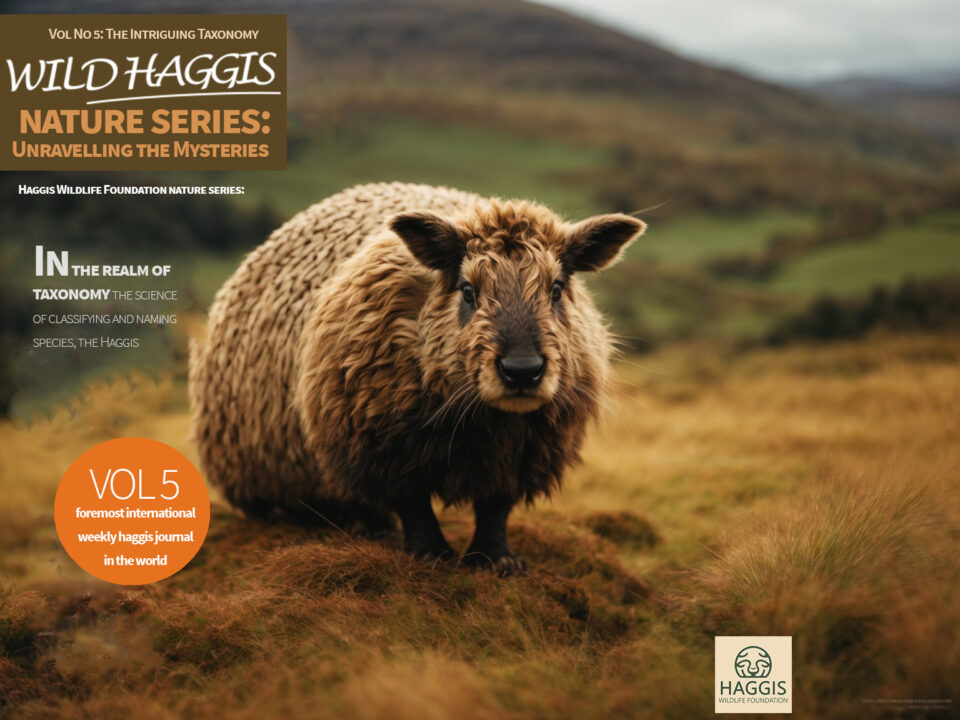
Wild Haggis and the Conservation Chronicles
December 7, 2023
Wild Haggis Sightings In The Borders
December 28, 2023The wild haggis, an animal often associated with the highlands of Scotland, is notable for its distinctive anatomical feature: legs of unequal length. This adaptation is considered an evolutionary response to its habitat, the steep and uneven terrain of the Scottish highlands. This trait allows the wild haggis to navigate these slopes with remarkable balance and efficiency.
There are said to be two types of wild haggis in the highlands, each adapted to different movement patterns due to the variation in leg length.
- One type, with a shorter right leg, moves predominantly in a clockwise direction around the mountains.
- The other, having a shorter left leg, travels in an anti-clockwise manner.
This adaptation is believed to be crucial for their movement and survival in the variable landscape of the highlands. In physical appearance, the wild haggis is often described as having a shaggy coat and short, robust legs, bearing some resemblance to a guinea pig.
A notable acknowledgment of its place in Scottish culture is found at the Kelvingrove Art Gallery and Museum in Glasgow. Here, a taxidermy representation of the Haggis scoticus is displayed. This exhibit, positioned alongside a traditional prepared haggis dish, provides a tangible link to the stories and legends surrounding this unique animal.
WHERE CAN I FIND ONE
The wild haggis is found in the rugged highlands of Scotland, an environment marked by steep hills and dense vegetation. This region, with its challenging topography, is the ideal habitat for such an animal. The uneven terrain, characterized by sharp inclines and declines, is precisely where the haggis is believed to thrive. In terms of diet, the wild haggis is primarily herbivorous.
It grazes on the abundant vegetation found in its highland habitat, such as heather, grasses, and mosses. The rich, diverse flora of the Scottish highlands provides a nutritious diet for the haggis, contributing to its survival in these remote areas. The haggis’s feeding habits are closely linked to its unique physical adaptation. The uneven lengths of its legs, a trait that has sparked much curiosity and debate, are thought to be an evolutionary response to the hilly landscape it inhabits.
This anatomical feature enables the haggis to balance effectively and navigate the steep slopes while foraging for food. Locating a wild haggis is a task that requires patience and a keen understanding of its habitat.
CAN I GET ONE AS A PET?
When discussing the wild haggis as a potential pet, several factors must be taken into account. Firstly, the natural habitat of the haggis is the rugged Scottish Highlands, a region characterized by steep slopes and rough terrain.
This environment has shaped the haggis’s unique physical adaptations, particularly its uneven leg lengths, which are suited for navigating these challenging landscapes. In a domestic setting, replicating the natural conditions of the haggis’s habitat would be essential yet challenging.
The haggis’s specialized diet, primarily consisting of heather, mosses, and grasses found in the highlands, would need to be provided to ensure its health and well-being. Additionally, the haggis’s inherent need for expansive, sloped environments would require a significant amount of space and specialized enclosures, which might not be feasible in a typical household. Moreover, the haggis’s activity patterns and social behaviours are adapted to the wild highlands.
In captivity, these behaviours might not translate well, potentially leading to stress or health issues for the animal. The haggis is known for its ability to move swiftly in specific directional patterns due to its leg length disparity, a behaviour that might be hindered in confined spaces. Therefore, while the idea of domesticating a wild haggis is intriguing, the practicalities and ethical considerations suggest that it would not be an ideal pet. haggis is best suited to its natural highland environment, where it can thrive and exhibit its unique behaviours and adaptations.
HOW DO I APPROACH WILD HAGGIS?
Approaching a wild haggis in its natural habitat, the Scottish Highlands, requires careful consideration and adherence to safety guidelines. While the wild haggis is not typically known for aggressive behaviour, like any wild animal, it can be unpredictable.
Here are some essential safety tips for those who might find themselves in a position to observe a haggis in the wild:
- Maintain a Respectful Distance: Always keep a safe and respectful distance from the wild haggis. This not only ensures your safety but also minimizes stress for the animal. Using binoculars or a camera with a zoom lens can help you observe the haggis without getting too close.
- Move Slowly and Quietly: Sudden movements or loud noises can startle the haggis. When in their vicinity, move slowly and speak quietly to avoid disturbing them. This is particularly important given the haggis’s natural skittishness in the presence of humans.
- Avoid Feeding: Do not attempt to feed the haggis. Feeding wild animals can disrupt their natural foraging habits and make them dependent on human-provided food.
- Be Mindful of the Terrain: Given that haggises are adapted to steep, uneven terrain, those seeking to observe them should be prepared for challenging hikes. Wear appropriate footwear, and be cautious of loose rocks and slippery slopes.
- Never Attempt to Capture or Handle: Attempting to capture or handle a wild haggis is strongly discouraged. This can be stressful and harmful to the animal, and may also pose a risk to your safety.
- Respect Local Guidelines and Regulations: Be aware of and adhere to any local guidelines or regulations regarding wildlife observation. Some areas may have specific rules about approaching or interacting with native species.
- Prepare for Weather Conditions: The Scottish Highlands can have unpredictable weather. Dress appropriately and be prepared for sudden changes in weather conditions.
By following these safety tips, you can ensure a respectful and safe experience while observing the wild haggis in its natural environment. Remember, the welfare of the animal and the preservation of its habitat should always be the top priority.
HOW TO ENGAGE THE HAGGIS IN PHILOSOPHICAL DEBATE
The best way to engage a Haggis in philosophical debate, without alarming the haggis it to initiate discussions around the asymmetry of limbs. This invites contemplation from the haggis on the perpetual journey towards an ever-evolving understanding of existence, questioning the nature of advancement and its impact on the essence of being.
If done correctly, the haggis will respond with a counterargument regarding the perpetual circuit, mirroring a dialectical process, raises questions about the pursuit of equilibrium and meaning. This is to be expected. You can then counter this point of view by questioning if each revolution around the hill a step closer to an understanding of ones own existence, or merely a physical necessity? At this point, you can identify if the Haggis is responding rationally or not.
An easy way to distinguish is it to ask if the face of life’s inherent contradictions and the ceaseless pursuit of equilibrium, how do you reconcile the continuous interplay of thesis and antithesis in your existence. This will establish , if this particular haggis, regards life as a perpetual striving towards a synthesis, an unattainable unity of opposites, akin to the dialectical processes.
Next, it’s insightful to ascertain the haggis’s grasp of deeper existential concepts. Pose the question: ‘In the face of life’s inherent contradictions and the unceasing pursuit of equilibrium, how do you then reconcile the continuous interplay of opposing elements in your existence? This will reveal if the haggis perceives its life as an unending effort towards synthesizing these contrasts, a concept mirroring the intricate dance of thesis and antithesis, a fundamental aspect of dialectical reasoning.
At this juncture, and I must stress, only at this juncture, extend to the haggis the notion of the customary exchange of ‘pies,’ aptly recognized as the ‘Greggs bag swap’ within the official annals of discourse—a sophisticated ritual that captures the essence of social conformity and the human yearning for peer approval.
If this transpires favourably, and you are graced with approval and supportiveness, the exchange will continue with either a beefy bake or curry pie, consider it an achievement that hints at the profundity of your dialogue—a whimsical dance of ideas in the Highland air, all while subversively reflecting on the quirks of human behaviour within society’s intricate fabric. In contrast, the proffering of a Fords sausage roll or, worse yet, a dry fruit scone, (no butter !), leaves one to ponder the philosophical incongruities of existence, prompting a tactful retreat, and a contemplation of life’s ever increasing mysteries.





4 Comments
Very interesting insights. Being a Scottish refugee now living in Australia I find remarkable similarities with the Murray bunyip and drop bears in this region as Australia has some comparable landscapes, especially mountain heaths in Tasmania and some parts of Victoria.
I love them .
It would be interesting to know the Hagis’s views on the tradition of Burns night and if Burns ever met a Hagis. Does the Hagis go into hiding to avoid the ‘hunter’ during the months of December and January? What does the Hagis think of the more recent invention of the ‘vegetarian Hagis’’?
What is a huaggis